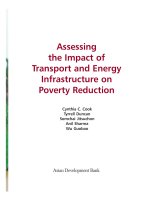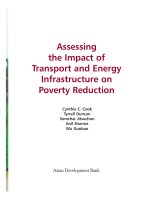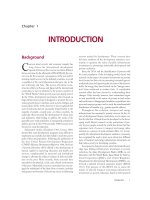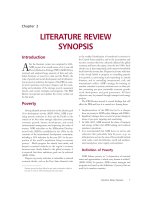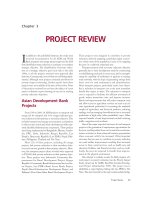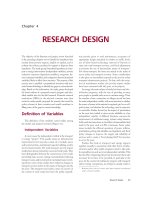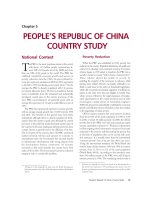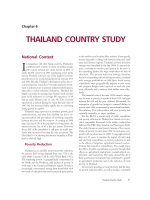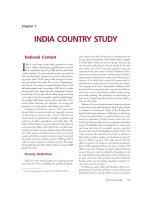Food is power the impact of colonialism and global capitalism on việt nams food map
Bạn đang xem bản rút gọn của tài liệu. Xem và tải ngay bản đầy đủ của tài liệu tại đây (1.15 MB, 47 trang )
Food is Power:
The impact of Colonialism and Global Capitalism on Việt Nam’s Food Map
Adam Mahoney
Northwestern University
B.S. Journalism and Sociology
World Learning, SIT Study Abroad, Vietnam: Culture and Development Fall 2019
Academic Director: Cô Duong Thanh
ISP Advisor: Mr. KC Low, Tượng Sơn Farm of Elephant Mountain Produce Company
2
Abstract
A millennium of colonization and war in Việt Nam has deeply convoluted culture,
livelihood and survival in its current nation-state. Traditionally, for Vietnamese people food has
represented the core aspects of life– a connection to history, tradition, identity and survival.
However, as a result of colonialism, neo-colonialism and imperialism, Việt Nam’s traditional
relationship with food consumption and production has been changed and co-opted. In the past
century, the country has seen a shift from collective uses of land for survival, towards a culture
that depends on creating for others. As a result of measures which were first enacted under
colonial rule, 93.6% of Việt Nam’s current GDP comes from exports of goods and services to
places like China, America and European nations— who all, at one point, had a colonial,
stronghold over the region. This ever-expanding relationship with exporting agriculture and other
raw materials has been masked by the terms globalization and global capitalism, also known as
imperialism, just under a new name. Globalization drives a process of diet convergence among
formerly colonized countries and their colonizers that challenges the predictions about future
patterns of food production and consumption.
Slowly, concern about the country’s relationship with exportation and its effects on Việt
Nam is creating critical considerations from both the government and local people. However,
Việt Nam’s colonial past has created an economy that is dependent on trade, making it a difficult
topic to navigate when prioritizing the survival of Vietnamese people. Interviews, surveys and
extensive research have revealed that the alteration of Việt Nam’s food map has damaging
effects on Vietnamese culture, physical health, labor safety and environmental protection. As
Việt Nam continues its developmental journey towards what is considered as ‘modernity,’ both
tangible and intangible manifestations of ethics, safety and human rights must be considered to
ensure protection of its people and land.
Keywords: Agriculture, Agronomy, Colonialism, Capitalism, Decolonial Studies, Developmental
Studies, Environmental health & protection, Sociology
3
Acknowledgements
I would first like to acknowledge the Cham, Khmer, K’ho and Lạch peoples whose land I
occupied to conduct this research in Đà Lạt and Hồ Chí Minh City. Much thanks to Cô Thanh
and Anh Tuan for giving me the support and tools to conduct this research independently. I also
would like to thank everyone at Tượng Sơn Farm of Elephant Mountain Produce Company Lâm
Đồng, especially Mr. KC Low, Ms. Nguyễn Tiến and Mr. Trần Thi for their hospitality and
receptiveness towards my research. While in Đà Lạt, I had the opportunity to work with Đà Lạt
University and Phiên Chợ nông sản hữu cơ Đà Lạt- Đà Lạt Organic Farmers Market, which were
both instrumental in my research. Thank you to Dr. Nguyễn Thị Hậu, Dr. Nguyễn and Dr.
Nguyễn Tất Thắng of Đà Lạt University and to the organizers of the Đà Lạt Organic Farmer’s
market for accepting my invitation for interviews. I would be remiss to not thank my host family,
Cô Duyên, Chú Bảo and Bạn Càng for accepting me into their homes and treating me with love
and respect. For my case study in Hồ Chí Minh City, I would like to thank the staff at Harvest by
5th Element restaurant, especially the manager Cô Vera for granting me space in their restaurant
and allowing me to conduct surveys.
I would also like to acknowledge my family back home for helping me to be in a position
to do this program and guiding my interests. I will forever have pieces of my heart throughout
Việt Nam, and I’m immensely grateful to the peoples currently occupying this land for letting me
experience it for myself.
4
Terminology
5
Figures
7
Introduction
7
Objectives
9
Methodologies, Limitations and Ethics
9
The impact of Transnational and Western Colonialism on false narratives within Globalization and
Development Theory
11
The Power of Food: Politics, Survival and Control
12
Việt Nam’s Colonization: Food’s History
14
China’s Domination (111 BCE- 938 CE, 1407-1427)
14
Background
14
Influence on food
15
Impact on Trade
16
French Colonization (1857-1954)
17
Background
17
Influence on food
17
Impact on Trade
18
Coffee
18
Rice
19
Meat Industry
20
Japanese Occupation (1940-1945)
21
Background
21
Influence on food and Impact on trade
22
United States Intervention (1940-1975)
22
Background
22
Influence on food and Impact on trade
23
Food Production Case Study: Đà Lạt
24
Background
24
Đà Lạt University
25
Culture
25
Environmental Concerns
26
5
Wastewater Treatment
26
Pesticide Disposal and Use
27
Transportation of Food Products
28
Phiên Chợ nông sản hữu cơ Đà Lạt- Đà Lạt Organic Farmer’s Market
28
Tượng Sơn Farm of Elephant Mountain Produce Company Lâm Đồng
30
Background
30
Economics of Agriculture:Tượng Sơn Farm
Discussion
Food Consumption Case Study: Hồ Chí Minh City
Background
30
32
32
32
Harvest Restaurant by 5th Element of Elephant Mountain Produce Company Lâm Đồng
Produce Department
33
General Food Consumption in Hồ Chí Minh City
34
Background
34
Discussion
38
Conclusion
39
Endnotes
41
Appendix
45
Terminology
1. Capitalism: An economic and political system in which a country's trade and economic
industry are controlled by private owners, rather than by the state, who prioritize profit
over protection.1
a. Global Capitalism: The fourth stage of Capitalism, which now transcends nations,
and thus is transnational, or global. In its global form, all aspects of the system,
including production, accumulation, class relations, and governance, have been
theoretically disembedded from the nation and reorganized in a globally
integrated way that increases the freedom and flexibility with which corporations
and financial institutions operate. The system is dictated by colonial and imperial
pasts, highlighting unequal power relations between nations and regions.2
6
b. Green Capitalism: A capitalist approach that believes the levers of the market can
be used to fix the broken environment— as natural resources dwindle and become
instinct, the market will be able to reverse and correct itself.3
2. Colonialism: A practice of domination, which involves the subjugation of one people to
another.4 The practice includes acquiring full or partial political control over another
country, occupying it with settlers, and exploiting it economically.5
a. Western Colonialism: A practice of colonialism enacted by Western nations
between the 15th Century until the mid 20th Century (With the exception of the
State of Israel, which is still colonizing Occupied Palestine).6
3. Commercial Farming: Farming for a profit, where food is produced by advanced
technological means for sale in the market. Often at the expense of food safety,
environmental protection and workers rights.7
4. Folx: A gender neutral collective noun used to address a group of people.8
5. Food Map: The process of finding out where people can buy and eat food, and what the
food needs of local people are. It is a type of needs assessment that aims to identify the
geographical areas or communities that have the greatest needs in terms of access to
food.9
6. Globalization: The process described as the growing interdependence of the world’s
economies, cultures, and populations, brought about by cross-border trade in goods and
services, technology, and flows of investment, people, and information.10
7. Imperialism: A policy of extending one country's power and influence through force over
another country, often for un-equitable economic benefits.11
8. Neo-Colonialism: The use of economic, political, cultural, or other pressures to control or
influence other countries, especially former colonial dependencies.12
9. Organic Farming: An agricultural system that uses ecologically based pest controls and
biological fertilizers derived largely from animal and plant wastes and nitrogen-fixing
cover crops. Modern organic farming was developed as a response to the environmental
harm caused by the use of chemical pesticides and synthetic fertilizers in commercial
farming.13
7
10. Subsistence Farming: Farming which uses traditional technology, low capital investment,
and in which the production of food for the individual farmer's family or community is
the priority.14
Figures
1. Product Exports by Vietnam to China 2016
2. Meat consumptionPork meat, Kilograms/capita, 2018
3. U.S. Imports from Việt Nam 2016
4. Tượng Sơn Farm Greenhouses
5. Tượng Sơn Farm Crops
6. How important is food to you?
7. Do you believe consuming Vietnamese food is an important part of what it means to be
Vietnamese?
8. Do you know where your food comes from?
9. Do you often think about where your food comes from before you eat it?
10. Do you take pride in Vietnamese food products, including agricultural crops and food dishes?
11. Do you have faith in the quality and safety of food grown in Việt Nam?
12. Do you actively search to eat only organic foods?
13. Which of these crops do you consider important to life in Vietnam?
14. All of the crops listed in question #x are not native to Vietnam and were brought by the French.
Does that change your answer to question #x?
15. What is your favorite Vietnamese dish or food product?
Introduction
Many consequences from colonial regins go undocumented and neglected, not always
intentionally, but because they are so intertwined with the newfound customs and daily
livlihoods of priorly colonized regions. In the case of Việt Nam, which has experienced nearly
1,000 years of colonization and war, colonialism has deeply convoluted culture, livelihood and
survival. One undeniably important aspect of culture, livelihood and survival that cannot be
neglected is food.
8
On a micro, individual level, people grow up eating the food of their own cultures. It
becomes a part of who each person is, how they are socialized and shape who they grow up to
be. Many folks associate food from their childhood with warm feelings and good memories and
it ties them to their families, holding a special and personal value for them. Food from families
often becomes the comfort food people seek as adults in times of frustration and stress. For
people who don’t have easy access to food, food also dictates their daily lives. Often their
existence is marked and regarded from meal to meal, whenever they are able to get one. Food is
sustenance, survival and existence.
On a larger scale, food is an important and undeniable aspect of culture. Traditional
cuisine is passed down from one generation to the next. It operates as an expression of cultural
identity and a way to preserve cultural identity from oppressors and colonizers. Each country or
community’s cuisine can reflect its unique history, lifestyle, values, and beliefs. Not only is food
sustenance, survival and existence, it is also history, tradition and identity.
So in the case of Việt Nam, food simply represents life– a connection to history,
tradition, identity and survival. However, as a result of colonialism, neo-colonialism and
imperialism, Việt Nam’s traditional relationship with food consumption and production has been
changed and co-opted. Historically, Việt Nam supported itself through collective and
collaborative uses of land and natural resources to provide food and shelter to its people.15
However, as a result of measures which were first enacted under colonial rule, 93.6% of Việt
Nam’s current GDP comes from exports of goods and services to places like China, America and
European nations— who all, at one point, had a colonial, stronghold over the region.16 This
ever-expanding relationship with exporting agriculture and other raw materials has been masked
by the terms globalization and global capitalism, also known as imperialism, just with a new
name. Globalization drives a process of diet convergence among developing and developed
countries that challenges the predictions about future patterns of food production and
consumption.
9
Objectives
I intend to study the impact of China’s, France’s, Japan’s America’s colonial and
imperial relationship with Việt Nam and its relationship with the country’s food production and
consumption in today's world dictated by global capitalism. Currently Việt Nam’s food map,
which outlines what is grown here, consumed here and exported from here, has deep roots in
colonialism. In many cases, traditional cuisine has either been erased or altered, highlighting
influences from China, France and America. This is important to study and document because it
represents a specific segment of neo-colonialism, the use of economic, political, cultural, or other
pressures to control or influence other countries, especially former dependencies. The research
will touch on cultural, environmental and economic aspects of Việt Nam.
Specifically, my research will attempt to document Việt Nam’s food map– cataloguing
what is grown and for who, differentiating between native and colonial crops and between crops
for internal consumption and export. The research will also attempt to draw the connection
between the agriculture industry and what dishes are actually consumed in Việt Nam, like Bánh
mì or Phở. Although the changes in Vietnamese culture due to the alteration of their relationship
with food may not be obvious in the day-to-day existence of the average Vietnamese person, it is
important to document how colonialism affects former colonies long after they’ve been ‘freed’. I
hope this study advances the acknowledgment and education surrounding the explicit and
implicit effects of colonial rule in places that are no longer explicitly controlled by colonial
governments.
Methodologies, Limitations and Ethics
This project utilized two different case studies: Food Production Case Study, Đà Lạt and
Food Consumption Case Study, Hồ Chí Minh City. Both quantitative and qualitative forms of
data were collected to analytically and critically address the guiding research questions. A total
of ten interviews were conducted, 9 in Đà Lạt and 1 in Hồ Chí Minh City, as well as 12
questionnaires collected in Hồ Chí Minh City. Background and supplemental research was
collected from 27 peer reviewed journals, as well as independent agencies like OECD, Asian
Development Bank, andWorld Bank. Data was also collected from government agencies: local
10
People’s committees in Đà Lạt and Hồ Chí Minh City, as well as the US dept. of Agriculture. In
Đà Lạt, three farmers, three professors from Đà Lạt University and three organizers from a local
food market were interviewed through a semi-structured process. The food market organizers
participated in a focus group discussion. In Hồ Chí Minh City, one interview took place with a
restaurant manager, as well as ethnographic observations in the restaurant. Four out of 12
questionnaires were collected in person, while 8 were administered through Google’s form
application; all participants were native Vietnamese folx. Five questionnaires were filled out in
Vietnamese, the other 7 questionnaires and all 10 interviews were in English. Seven out of 10
interviews conducted were scheduled through convenience sampling, as I had been in contact
with the interviewees prior to beginning the research. Questionnaires were also conducted
through convenience sampling, however snowball sampling also took place as the form spread.
The two case studies were driven by primary research, however much of the colonial
studies come from secondary research, but were guided by word of mouth from primary research
subjects. Quantitative data was used to support individual experiences and accounts from the
mentioned sources. All collected data was used to contextualize how Viet Nam’s relationship
with food has changed over time, and subsequently how this has affected the livelihood and
culture of Vietnamese folx.
As a non-Vietnamese person, there were many ethical concerns and limitations I was
exposed to throughout the study. Namely, there were large language and cultural barriers which
made it difficult to fully connect with interviewees, limiting how much they may have trusted me
to tell their stories. There were also power dynamics that must be addressed related to my
standing as an American and America’s controversial relationship with Việt Nam. I also found
ethical concerns with anonymity, especially as much of my data was collected from an
internationally organized farm, farmers market and restaurants. There were also ethical concerns
with attempting to outline effects on Viet Nam’s culture, especially considering that I am not
Vietnamese and I’m not a part of the culture. Lastly, the largest limitation was due to the time
constraints of the project which limited my abilities to fully delve into the project, affecting the
numbers of interviews, questionnaires and background research conducted.
11
The impact of Transnational and Western Colonialism on false narratives within
Globalization and Development Theory
There have been many attempts to theorize and define the term ‘development.’ In many
cases, development is used to assert a certain status that has been placed on a level of superiority,
in order to socialize people, institutions, countries, etc. Often, development and developmental
aspirations are inserted by groups with dominance and power. In the case of Việt Nam, the term
‘development’ is a product of colonialism and westernized supremacy, used to erase and
delegitmize indeginous, traditional and pre-colonial histories. Development is theorized to exist
in a natural state, as it explains “the processes of change in societies and how they take place.”17
In comparison, also in a natural state, there have been folx living in Southeast Asia for at least
70,000 years, according to scientific research.18
Modernization theory, the current leading development theory, came to fruition after the
end of World War II, and as a response to a growing united world communist movement.19 The
theory is based on the ideals that modern societies are more productive, children are better
educated, and the needy receive more welfare…” as a result of “social structural differentiation”
or distinct social and political structures within a nation.20 The definitions of development in
practice are consequences of ideology that favors certain narratives over others, minimizes any
social or political structure that doesn’t follow neo-liberal ideologies and ignores centuries of
colonial histories which have resulted in unequal social and economic power balances between
countries. Development, as it has been theorized and defined, is not an inherent, natural state, but
a by-product of colonialism, exploitation and false notarization of western beliefs to promote
physical, environmental, intellectual and cultural violence and control against oppressed and
marginalized peoples across the globe.21
Development, as we currently accept it, rests upon the ideals that there is a singular way
of living, which should be accepted and aspired to across the globe. In the case of modernization,
this inspired lifestyle is overwhelmingly western, white and capitalist. Dossa describes
development as “the logic of Western dominance, located in the 'metaphysics of white
mythology.'”22 Uncoinicidentally, the ideas of western, white and capitalists, or ‘white
12
mythology’ fueled colonialism throughout Africa and Asia for centuries. Robert Emerson
outlines the falacies of colonialism, which directly relate to the falacies of development: “cultural
superiority which justifies colonial rule either on a permanent basis, since the 'natives' are
congenitally incapable of overcoming their backwardness, or for as long a period - seen, perhaps,
as lasting many generations or even centuries - as they are regarded by their colonial masters as
being incompetent to manage their own affairs.”23 The idea that Việt Nam, as it naturally exists,
is not a developed state is another form of cultural superiority used by western nations to dictate
and homogenize life in Việt Nam.
The Power of Food: Politics, Survival and Control
There is a direct correlation between colonial histories and the meaning of food and
survival for indeginous folks across the globe, as well as the global transformation of food
regimes as a product of colonialism. Research about this global phenomenon has been conducted
extensively across the world, but is limited in Việt Nam.
The Food Empowerment Project is a volunteer-based non-profit organization whose
mission statement is "to create a more just and sustainable world by recognizing the power of
one's food choices."24 In the report, “Colonization, Food, and the Practice of Eating” the
organization connects colonial history to the meaning of food and survival for indeginous folks
across the globe. Although the report does not single out examples of Việt Nam, it creates a
global picture surrounding the lasting effects of colonialism on people’s culture and daily
livelihoods. The study mentions that most studies about colonization “generally focus on the
social, political, and economic changes forced upon Indigenous populations, the matter of
food—the very source of survival—is rarely considered,” pointing towards the significance and
necessity of this type of research.25 The paper details how European colonizers were fully aware,
and purposefully, eradicated traditional diets and replaced them with colonial diets as a form of
social control. “In the minds of Europeans, food not only functioned to maintain the bodily
superiority of Europeans, it also played a role in the formation of social identity.”26 Europeans
used food as a way to dictate social identity, but also falsely idolize their own physical beings, as
seen with the growth of global white supremacy. The research also connects the cultural aspects
13
of religion with the need for Europeans to change traditional diets and the need for religious
imperialism. As a product of this imperialism, Europeans often brought new crops and animals to
lands. In the case of Việt Nam this was an influx of beef, vegetables and grains that were not
native to the region, forever changing the diet of Vietnamese people. Along with these new
crops, colonization also led to the creation of plantation style farms in most colonized regions.
For Việt Nam, this was coffee, rubber and tea plantations. Often these plantations were utilized
as cheap or free labor for colonizers, like the French, to extract resources and crops for
consumption in Europe.
Although colonization both tangibly and intangibly altered native food map’s, it is
important to note that food has always been a form of resistance for colonized bodies. Native
diets have found ways to navigate being forced to integrate Western foods to create their own
foods like, in the case of Việt Nam, Bánh mì or Bánh xèo. As Alverez says, “food has never
merely been about the simple act of pleasurable consumption—food is history, it is culturally
transmitted, it is identity. Food is power.”27
The paper “From Colonialism to Green Capitalism: Social Movements and Emergence of
Food Regimes” suggests that this alteration of food maps due to colonization have continued in
our modern systems of global capitalism and globalization. The paper describes that a
corporate-environmental food regime is emerging as part of a larger restructuring of capitalism.
This is shown globally as the world's diet is becoming increasingly Western and increasingly
wasteful in terms of land and water consumption. We see this currently in Việt Nam with the
increasing number of non-native crops grown purely for Western consumption. Land is being
colonized by the West for food products that don’t necessarily define or add to the Vietnamese
diet. Led by food retailers, agrofood corporations are selectively appropriating demands of
environmental, food safety, animal welfare, fair trade, and other social movements that arose in
the interstices of the second food regime.28 If this process is continued the paper argues that “the
new food regime promises to shift the historical balance between public and private regulation,
and to widen the gap between privileged and poor consumers as it deepens commodification and
marginalizes existing peasants.” 29
Historically in Việt Nam this was seen under French rule, the
construction of irrigation works, chiefly in the Mekong delta, and the area of land devoted to rice
14
cultivation quadrupled between 1880 and 1930. During the same period, however, the individual
peasant’s rice consumption decreased without the substitution of other foods.30 Not only did this
change the cultural and physical consumption of food for Vietnamese people, it also mightily
shifted the country’s landscape and environment. This phenomenon was recently documented in
an OxFam report which stated that the richest man in Việt Nam earns more in a day than the
poorest Vietnamese earns in 10 years.31
Not only is food power in cultural and economic aspects, it also directly dictates
environmental concerns. Việt Nam is now among the most vulnerable nations to climate change
impacts according to a recent International Panel on Climate Change report that emphasized the
environmental concerns of Việt Nam’s growing production industry which utilizes the use of
harmful plastics and warns of the costly effects climate change will have on it’s agricultural
system.32 Additionally, by 2030, rising sea levels in the delta would expose 45% of the land to
extreme salinization and crop damage, with rice productivity falling by nine percent.33 There are
also negative implications between Việt Nam’s current energy consumption and dependence on
agriculture. Agriculture accounts for 80% of the surface-water consumption and with increases
in energy demand to supply urban and industrial centers, conflicts over water management are
likely to increase.34 This development has put Việt Nam “on a path that makes it a member of the
global neoliberal community, which ensures that inequity and corruption will continue to persist
there,” as the country becomes more ‘modernized’ and ‘developed.’35
Việt Nam’s Colonization: Food’s History
China’s Domination (111 BCE- 938 CE, 1407-1427)
Background
Modern Việt Nam, as we know it, has been traced to “legendary kingdoms ruled by
mythical monarchs,” due to systemic erasure of the region’s history under Chinese colonialism.36
Developmental theories, like modernization, assert that countries should aspire to be like
modernized societies as in America, Hong Kong and many European countries, however they
fail to account for instances like erasure of history and traditions which these same powerful
societies use against so-called nations that need to become ‘developed'. As Chinese rulers
15
disparaged through land and lives in modern day Việt Nam for roughly one thousand years, they
purposefully erased any remnants of ancient history in the region.37 This exercise of power and
state formation is inherent to the practice of history and domination.38
Chinese domination in Việt Nam was spearheaded by scholars and government officials
who were historically ostracized in mainland China.39 The colonial reign controlled many aspects
of life in Việt Nam, some of which are still dominating in the present day, including agriculture,
education and infrastructure. The initial purpose of Chinese rule was to control the Red River
Delta in Northern Việt Nam, a geographical terrain for trading supplies with other powerful
countries like India and the Roman Empire. This process was abetted by the efforts of Chinese
governors to achieve complete sinicization-- the practice of bringing people who are not of
Chinese descent under the influence of Chinese culture-- through the imposition of Chinese
language, culture, customs, and political institutions, often erasing any cultural and intellectual
artifacts belonging to ancient Việt Nam along the way.40 Throughout China’s campaign,
resistance and revolution defined a lot of Vietnamese existence. The first major rebellion against
Chinese rule broke out in 40 CE, led by the Trung sisters.41 Rebellions maintained until Việt
Nam gained independence in 1427.
Việt Nam’s current relationship with China is heavily reliant and influenced by its
colonial relationship. Currently, they are engaged in a sovereignty battle over the South China
Sea. Its reported that, “a new dispute erupts between China and Vietnam about once a year,” but
this battle is over an “energy exploration in an area in the sea that both countries call their
own.”42 The sea also sees 1⁄3 of all products traded in the world go through its water per year, so
there's no end seen in the near future.43
Influence on food
Việt Nam “at one of the crossroads of the Asian world,” has been strongly influenced by
China in terms of chopsticks, noodles, woks, and stir frying, which are accepted as part of
modern Vietnamese culture.44 New World vegetables like chili peppers and corn, which were
present in the Ming Dynasty also made their way to Việt Nam. The Chinese influence on cultural
foods remains strongest in North Việt Nam to this day, as that is where their colonial empire
first began and is closest to mainland China. From China, they brought their basic economy built
16
around wet rice farming. Rice cultivation, dependent on weather and complex systems of
irrigation, requires cooperative labor. Việt Nam used this collective spirit in food production, but
also in protection of their own communities against Chinese rule. This was also the first time
Việt Nam utilized rice for export and economic gain, as Southern China used Northern Việt Nam
as direct pipeline for food supplies. 4546
Impact on Trade
There has been proven correlations between priorly colonized regions and their
relationship with trade. Exploitative numbers of trade accumulation of natural resources has
solidified that “development is not neutral; it is often a facade for 'imperialism, exploitation and
dependency,” all of which are results of colonialism.47 In the case of China, they used Việt Nam
historically as a tool to feed their own citizens in mainland China-- this has persisted today.
China is the second largest destination, only behind the United States, for Vietnamese exports at
$21.95 Billion (USD). Additionally, Việt Nam depends on China for over $50 Billion worth of
products imported into the country. Việt Nam is the only country in the top 10 of China’s export
destinations that is also not in the top 10 in global population.
Product Exports by Vietnam to China 2016 (Figure 1)*
Total: $21.95 Billion (USD)Top 3: Electrics ($6.4 B), Vegetables ($3.99B) and Clothing
($2.59B)
Source: World Integrated Trade Solution of World Bank48
17
French Colonization (1857-1954)
Background
France’s military activity in Việt Nam began in 1857, when the French Navy attacked Đà
Nẵng harbor with 14 ships in response to Emperor Thiệu Trị’s suppression of Catholic
missionaries. Sài Gòn was seized in early 1859 and, in 1862, Emperor Tự Đức was forced to
sign a treaty that gave the French three eastern provinces of Việt Nam.
In the case of French colonialism, “Việt Nam was a case of ‘colonization without
development or modernity.”49 The French were “primarily concerned with facilitating the
extraction Việt Nam's agro-mineral resources to exploit...”50 This exploitation is a result of the
free market, neo-liberal system which values consumption over protection. Whatever economic
progress Việt Nam made under the French after 1900 benefited only the French and the small
class of wealthy Vietnamese created by the colonial regime. Not to mention, during French
colonial reign over 200,000 Vietnamese people died fighting for their homeland’s
independence.51 Throughout this struggle, thousands were imprisoned in places like Hỏa Lò
Prison— where not only were Vietnamese physically and violently suppressed, the French made
sure to also suppress any sense of cultural solidarity or power brewing between their Vietnamese
subjects. With all that being said, and nearly one hundred years of violent physical,
environmental, intellectual and cultural damage against the Vietnamese people, in order for Việt
Nam to be accepted as a developed and accepted global state, they are expected once again to
bow to colonial powers like France and follow their lead.
Influence on food
When French colonists arrived in Việt Nam, they brought several ingredients that did not
yet exist in the East, such as asparagus and potatoes. The words for these ingredients evoke their
origins: asparagus are known as Măng tây, or Western bamboo shoots. They are seen as a special
occasion sort of vegetable, hinting towards the high status that colonial products are awarded;
asparagus soup is a very common first course for weddings.52 Potatoes are yet another vegetable
introduced by the French, which is surprising in and of itself, because until Antoine Parmentier
popularized them in the 18th century, a century before colonization, the French believed that
18
potatoes were unfit for human consumption and used them as food for farm animals, especially
pigs.53
French colonization also led to the introduction of many of the main aspects of food that
are globally associated with Việt Nam: Coffee, Bánh mì and Phở . The French had started
drinking coffee in the 1600s when it was introduced from the Middle East and brought it with
them to Việt Nam 200 years later. It was quickly adapted into the local cuisine and culture,
largely because the country has an excellent climate for growing coffee — the proof: today, Việt
Nam is the world’s second largest coffee exporter.54 Bread is not common in East Asia, but when
the French colonists arrived in Việt Nam, they came armed with both guns and baguettes. The
Vietnamese adapted this bread and began using it in their local cuisine, often regarded as a form
of resistance against French imposition. while the Vietnamese style of baguette is similar to the
French baguette, it is made with rice flour instead of wheat flour, giving it a wholly distinct
flavor and texture.55 These baguettes are used as the base of one of the most famous Vietnamese
dishes worldwide, Bánh mì. The sandwiches contain a combination of grilled meat, coriander,
pickled vegetables and pâté, highlighting French influences of raw vegetables, pâté and meat.56
Phở is a combination of Vietnamese rice noodles and French meat broths; some even say that the
name Phở may be a Vietnamese appropriation of the French pot au feu or stew.57 The presence of
beef — tripe, thinly cut raw steak and meatballs — further belies the European influence in this
case, as beef is uncommon in other traditional East Asian cuisines.
Impact on Trade
Many of the main crops, food products and food practices, introduced into Việt Nam are
now dominating the country’s economy, namely the Coffee, Rice and meat industries. This has
various impacts on life in Việt Nam, including changing the physical use of land, what is eaten
by citizens, relationships with countries across the globe, cultural relationships between ehnic
minorities and Kinh folx and agricultural practices.
Coffee
For the last decade, Việt Nam has alternated between the top three positions in the global
rankings of coffee production and exportation. As of last year, Việt Nam was the world’s second
19
largest exporter of coffee beans and the largest robusta exporter. Coffee exports account for
nearly 10% of the country’s total shipment of agro-forestry-fisheries.58
Vietnamese instant coffee is now available in 70 countries and territories worldwide.59
Its global market share of coffee has jumped from 0.1% to 20% in just 30 years.60 After the
country’s shift towards a more open and free market, coffee production grew by 20%-30% every
year in the 1990s. The industry now employs about 2.6 million people, with beans grown on half
a million smallholdings of two to three acres each.61 Vietnamese consumption of their
homegrown coffee is limited, more than 90% of coffee grown is for export. Roughly ⅓ of all
coffee consumed in the UK is Vietnamese grown.
The WWF estimates that 40,000 square miles of forestry has been cut down since 1973,
much of it for coffee farms, and experts say much of the land used for coffee cultivation is
steadily being exhausted.62
Rice
Rice is both a staple of food consumption in Việt Nam and food exportation. For the
French, the basic objective of exporting rice was to meet its large costs of colonization.63
Through their plantation style politics, they utilized Vietnamese labor to maximize their own
profits. They developed a maze of canal system in the Mekong delta to grow three rice crops in a
year. Although the French are long gone, the practices they instilled to maximize profit and
utilize labor and land, often in exploitative and destructive modes, are still being used by Việt
Nam to maintain their position as a top rice exporter. Besides a roughly 30 year period between
the end of French colonial and Đổi Mới, an economic reform program that focused on poverty
eradication, Việt Nam has had world leading outputs of rice. Now, Việt Nam is one of the world's
top three rice exporters with yearly rice output of 26 to 29 million tons.64 In 2018, Việt Nam
earned more than 3 billion USD from exporting 6 million tons of rice. However, the country is
looking to limit its export dependency in attempts to limit environmental impact.65
20
Meat Industry
While the French occupied Việt Nam, they established cattle farms, exasperated pork
consumption and increased shrimp farming further ingraining meat into the daily diet of the
country and shaping the region's current relationship with beef, pork and shrimp.
As the world’s 14th most populated country, Việt Nam and its 94 million people are
increasing their livestock consumption as they experience higher income and population growth.
Despite the relatively stable growing trend of livestock production over the past few years, meat
output has not managed to keep up with the current consumption demand Currently, the country
is forecasted to consume 4.5 million tons of livestock in 2019.66 It is shown that, “a higher
growth rate for beef and poultry is a result of a new cultural belief which is a preference towards
western and/or imported products.”67 In 2015, the country’s imported meat value was estimated
to have reached US$234.7 million, and by 2017 the number nearly doubled at US$410 million,
according to the Ministry of Agriculture and Rural Development.68 After introducing large scale
cattle farms to the region, France maintains a lot of control over the quality of Vietnamese beef.
In only a six month period in 2016, French companies had exported 100 tons of frozen beef and
270 tons of beef offals to Việt Nam.69
Shrimp has been a mainstay in Vietnamese diet for centuries, however since exporting
the product under French control, problems have arisen. As of 2018, Việt Nam is the world’s
fourth largest seafood exporter, with one of the fastest-growing fishing fleets.70 It sends products
such as shrimp to 170 countries, and in 2017 it exported $8.5B worth of seafood, with the top
export destinations being the EU,including France, followed by the US.71 The country aims to
increase exports to $10.5bn this year.72 According to an investigation by the Environmental
Justice Foundation, children as young as 11 are working aboard Vietnamese vessels fishing
illegally for seafood that could end up on sale in supermarkets in the EU and US.73
Although, Pork was a part of the Vietnamese diet before French control, it was also
exasperated under the creation of large scale farms by French colonists. Now, Việt Nam is set to
become the world's top pork consumer. Vietnamese currently consume an average of 29.9
kilograms of pork per capita, however by 2023, the Organization of Economic Cooperation and
Development expects that number to rise as high as 33.9 kilograms per capita, making Việt Nam
21
the world’s top consumer of pork.74 While this economic prosperity has allowed Vietnamese to
incorporate more meat into their diet, the country’s farmers now face a challenge: finding
enough corn and soybeans to feed Việt Nam’s 28.3 million pigs. As a result, both foreign and
local firms have invested heavily in the construction of local feed mills to meet the needs of
Vietnamese pig farmers. Foreign feed producer Cargill is currently constructing its 12th feed mill
in Việt Nam.75 Currently, about 70% of Việt Nam’s pig feed ingredients come from abroad.76 By
2022, Việt Nam’s domestic market for animal feed is expected to reach a value of US$10.55
billion.77
Meat consumptionPork meat, Kilograms/capita, 2018 (Figure 2)
Source: OECD Agriculture Statistics: OECD-FAO Agricultural Outlook (Edition 2019)
Japanese Occupation (1940-1945)
Background
Japan entered Việt Nam under the guise called a Greater East Asia Co-Prosperity Sphere,
an economic coalition of Asian nations. Together, Japan argued these Asian countries would
expel Western imperialists and capitalists then share trade, resources and commodities between
themselves. With France preoccupied in World War II, Japan saw its opening and entered
Northern Việt Nam in 1940. For most of their occupation, the Japanese left the French colonial
government in place, though its authority was greatly diminished, creating a dual imperialist
empire.
22
The Japanese presence in Việt Nam also attracted foreign attention, particularly from the
United States. Working to suppress global Japanese expansion and also wanting to protect its
imports of raw rubber, half of which came from Việt Nam, the US helped Northern Việt Nam
dispel Japanese occupation by 1945.
Influence on food and Impact on trade
When the Japanese occupied Việt Nam they exploited the rich delta by exporting rice to
their country, which denied several million Vietnamese of their basic staple.78 In 1941, the
French puppet government granted Japan ‘most favored nation’ status, meaning the bulk of
Vietnamese exports were allocated to Tokyo at low prices. While Việt Nam was occupied by
Japan, the Allies, especially the United States, often bombed roads, making the transport of rice
from the south to the north extremely hard.79 Both France and Japan forcibly hoarded food from
farmers to feed their troops, while the French administration was broken and unable to supply
and distribute the food.80 The inadequate food supply caused the famine in Việt Nam; starting
with 1943, peaking in March–May 1945 and continuing till the end of Pacific war there was
unprecedented starvation. Two million Vietnamese people were reported to have died of
starvation which was attributed to the Japanese rule and was further compounded by
unprecedented floods.81
United States Intervention (1940-1975)
Background
The United States first began to play a major role in Việt Nam during the second World
War in attempts to stop Japan from gaining more control in the region. Although, superficially
initial intentions by entering the region were positive, it quickly turned into an imperialistic
relationship between the US and Việt Nam. After supporting Việt Nam in their fight for
independence, they started using the region for their own gain. On August 4, 1953 during a
speech to US Congress, then president Dwight Eisenhower admitted, that the United States
relationship with Việt Nam, within the Indochina region, was strategic in support of building the
United States’ riches and power, not a “gratuitous offer” of support. The US chose to impose
itself in the region, not for the greater good or to contribute to the world’s ‘modernization,’ but,
23
as Eisenhower said, because the US needed to dominate that region “for its security, its strength
and its possibility to obtain what it needs among the riches in Indochina and Southeast Asia.”82
This utilization of control continued as the United States supported the anticommunist
government led by Ngơ Đình Diệm in the South. US intervention expanded into neighboring
Cambodia and Laos, playing a major role in as many as 2 million civilians deaths and some 1.1
million deaths of North Vietnamese and Việt Cộng fighters.83 This included bombing and
spraying deadly chemicals on farmland and villages. More than 10 years of U.S. chemical
warfare in Việt Nam exposed an estimated 2.1 to 4.8 million Vietnamese people to Agent
Orange.84 U.S. aircrafts also targeted 4.5 million acres across 30 different provinces in the area
below the 17th parallel and in the Mekong Delta, destroying inland hardwood forests and coastal
mangrove swamps.85 This has had deep effects on public health, the agriculture industry and
current relationships with the US.
Influence on food and Impact on trade
After the war, the US severed diplomatic ties with Việt Nam and imposed a full trade
embargo, leaving the country to handle the destruction to its farmland and city hubs. The
dangerous quantity of residual dioxin in the earth, as a result of US actions, still thwart the
normal growth of crops and trees, while continuing to poison the food chain.86 The Mekong is
one of the most fertile regions in the world, however after its poisoning during the war, its
fertility dropped significantly. Between reunification and Đổi Mới, the country faced increased
food shortages and bad crop outputs, attributed to poor soil quality and drought.87 This caused a
failure of the reunified governments first 5 year plan which focused on self-subsistence. The
government rationed, or restricted, food during the period, in hopes for a solution, which would
end up being the lift of the US trade embargo. Increased relationship with the US allowed the
country the opportunity to import food, while also developing its own export culture as soil
safety improved.88 Now, the US influences Vietnamese food with the expansion of western
restaurants and dictating many food practices, particularly organic farming certification.
Trade relations also exhibit American influence and control over what is grown and
consumed in the country:
U.S. Exports to Việt Nam89
24
1. U.S. exports to Việt Nam reached a record $4.0 billion in 2018, making Việt Nam the
seventh-largest destination for U.S. agricultural products.
2. U.S. exports of dairy to Việt Nam reached $145 million in 2018, a 29-percent increase
from 2017.
3. The U.S. has begun to utilize Việt Nam as a destination for meat scraps to cut waste. U.S.
beef exports to Việt Nam grew by 35 percent from 2017 to 2018 to nearly $82 million.
U.S. pork saw tremendous growth in 2018, growing by 191 percent to $35 million.
4. In 2018, the United States was the seventh largest exporter of food preparations to Việt
Nam, a billion dollar sector due to tourism.
5. U.S. fresh fruit exports reached a record $102 million in 2018.
6. Feeds and fodders imports grew to $707 million in 2018 from $645 million in 2016.
7. U.S. vegetable exports reached $920 million in 2018.
U.S. Imports from Việt Nam 2016 (Figure 3)90
● Values are in thousands, i.e.: 38,473,176.75 = $38.473 Billion
Food Production Case Study: Đà Lạt
Background
The land that is now known as Đà Lạt was initially occupied by Lạch and K’ho
indigenous folx who survived by subsistence farming and collective living.91 Once France began
to dominate Việt Nam, they saw the need for a local vacation spot, so modern Đà Lạt was a
project established by French colonizers for “colonial administrative officials to go up there for
rest and recreation rather than take leave back in their motherland.”92 This undoubtedly has had a
25
huge impact on the way Đà Lạt developed into the agricultural and tourist hub that it is today.
The French introduction to the region led to the displacement of thousands of native folx and a
complete transformation of the culture, demographics and livelihoods of people in the region. By
April 1944, Đà Lạt had up to 5,600 Westerners, a record number.93 Although Đà Lạt was a
refuge for French Colonizers during their reign, after the country gained independence in 1954 it
was still heavily influenced by the West. Currently, Đà Lạt’s Gross Domestic Product (GDP) is
70% from the tourism industry, which effectively maintains the often Westernized image of the
region.94 Its second biggest economic contributor is agriculture. Since the mid-20th century, Đà
Lạt has served as a center for the growing of temperate-zone vegetables for sale in Hồ Chí Minh
City. The rich red soil supports rubber, tea and coffee plantations as well. Most temperate-zone
vegetables grown in the region were brought during French colonization, also when all rubber,
tea and coffee plantations were created.95
Đà Lạt University969798
Đà Lạt University was founded in 1957 at the request of Pierre Martin Ngô Đình Thục, a
member of the ruling family of South Việt Nam leading up to the American-Việt Nam War.
Presently, the university offers over 30 programs at the undergraduate level and graduate
programs in Mathematics, Physics, Chemistry, Biology, History and Philology. As a leading
research university in Việt Nam, they have award-winning faculty in multiple disciplines from
sociology to environmental science.
Culture99
Đà Lạt’s cultural development is heavily intertwined and reliant on the city’s colonial
past, namely how its past has transformed the region's population, daily livelihood and food map,
and subsequently its culture. Besides the development of Đà Lạt as a vacation and tourist spot,
the French physically transformed the land and altered the way its resources were utilized. They
introduced coffee, rubber and tea plantations, completely altering the lifestyle of local folx.
Before colonization, the region provided for itself through seasonal, subsistence farming.100 Since
colonization and the introduction of commercial, market based farming into the region, farming
is now conducted on a large-scale and entirely year round.

